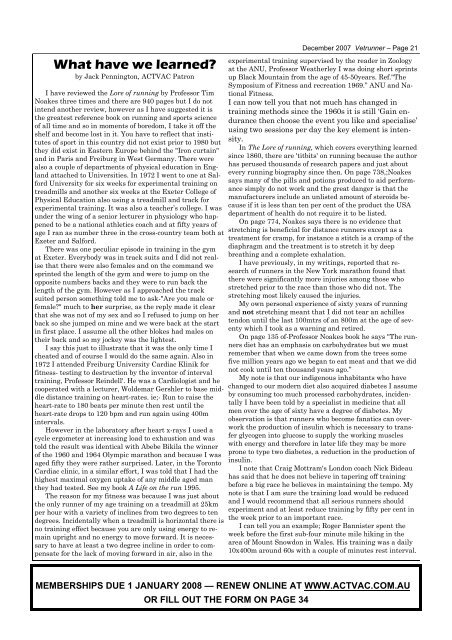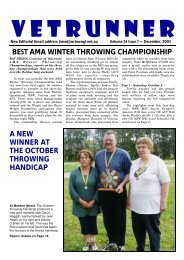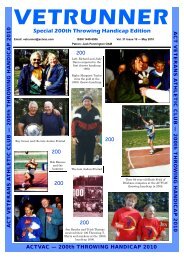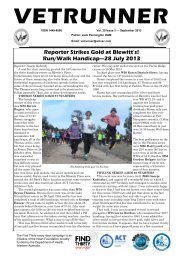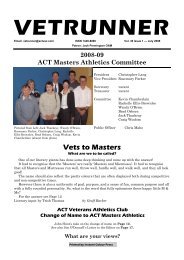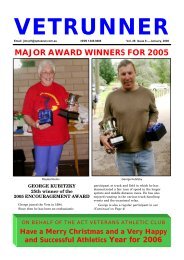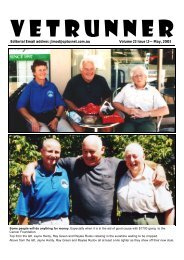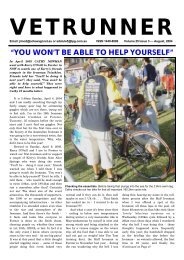Vetrunner December 2007.pub - ACT Veterans Athletics Club
Vetrunner December 2007.pub - ACT Veterans Athletics Club
Vetrunner December 2007.pub - ACT Veterans Athletics Club
You also want an ePaper? Increase the reach of your titles
YUMPU automatically turns print PDFs into web optimized ePapers that Google loves.
What have we learned?by Jack Pennington, <strong>ACT</strong>VAC PatronI have reviewed the Lore of running by Professor TimNoakes three times and there are 940 pages but I do notintend another review, however as I have suggested it isthe greatest reference book on running and sports scienceof all time and so in moments of boredom, I take it off theshelf and become lost in it. You have to reflect that institutesof sport in this country did not exist prior to 1980 butthey did exist in Eastern Europe behind the "Iron curtain"and in Paris and Freiburg in West Germany. There werealso a couple of departments of physical education in Englandattached to Universities. In 1972 I went to one at SalfordUniversity for six weeks for experimental training ontreadmills and another six weeks at the Exeter College ofPhysical Education also using a treadmill and track forexperimental training. It was also a teacher’s college. I wasunder the wing of a senior lecturer in physiology who happenedto be a national athletics coach and at fifty years ofage I ran as number three in the cross-country team both atExeter and Salford.There was one peculiar episode in training in the gymat Exeter. Everybody was in track suits and I did not realisethat there were also females and on the command wesprinted the length of the gym and were to jump on theopposite numbers backs and they were to run back thelength of the gym. However as I approached the tracksuited person something told me to ask-"Are you male orfemale?" much to her surprise, as the reply made it clearthat she was not of my sex and so I refused to jump on herback so she jumped on mine and we were back at the startin first place. I assume all the other blokes had males ontheir back and so my jockey was the lightest.I say this just to illustrate that it was the only time Icheated and of course I would do the same again. Also in1972 I attended Freiburg University Cardiac Klinik forfitness- testing to destruction by the inventor of intervaltraining, Professor Reindell'. He was a Cardiologist and hecooperated with a lecturer, Woldemar Gershler to base middledistance training on heart-rates. ie;- Run to raise theheart-rate to 180 beats per minute then rest until theheart-rate drops to 120 bpm and run again using 400mintervals.However in the laboratory after heart x-rays I used acycle ergometer at increasing load to exhaustion and wastold the result was identical with Abebe Bikila the winnerof the 1960 and 1964 Olympic marathon and because I wasaged fifty they were rather surprised. Later, in the TorontoCardiac clinic, in a similar effort, I was told that I had thehighest maximal oxygen uptake of any middle aged manthey had tested. See my book A Life on the run 1995.The reason for my fitness was because I was just aboutthe only runner of my age training on a treadmill at 25kmper hour with a variety of inclines from two degrees to tendegrees. Incidentally when a treadmill is horizontal there isno training effect because you are only using energy to remainupright and no energy to move forward. It is necessaryto have at least a two degree incline in order to compensatefor the lack of moving forward in air, also in the<strong>December</strong> 2007 <strong>Vetrunner</strong> – Page 21experimental training supervised by the reader in Zoologyat the ANU, Professor Weatherley I was doing short sprintsup Black Mountain from the age of 45-50years. Ref."TheSymposium of Fitness and recreation 1969.” ANU and NationalFitness.I can now tell you that not much has changed intraining methods since the 1960s it is still ‘Gain endurancethen choose the event you like and specialise’using two sessions per day the key element is intensity.In The Lore of running, which covers everything learnedsince 1860, there are 'titbits' on running because the authorhas perused thousands of research papers and just aboutevery running biography since then. On page 738,;Noakessays many of the pills and potions produced to aid performancesimply do not work and the great danger is that themanufacturers include an unlisted amount of steroids becauseif it is less than ten per cent of the product the USAdepartment of health do not require it to be listed.On page 774, Noakes says there is no evidence thatstretching is beneficial for distance runners except as atreatment for cramp, for instance a stitch is a cramp of thediaphragm and the treatment is to stretch it by deepbreathing and a complete exhalation.I have previously, in my writings, reported that researchof runners in the New York marathon found thatthere were significantly more injuries among those whostretched prior to the race than those who did not. Thestretching most likely caused the injuries.My own personal experience of sixty years of runningand not stretching meant that I did not tear an achillestendon until the last 100mtrs of an 800m at the age of seventywhich I took as a warning and retired.On page 135 of-Professor Noakes book he says "The runnersdiet has an emphasis on carbohydrates but we mustremember that when we came down from the trees somefive million years ago we began to eat meat and that we didnot cook until ten thousand years ago.”My note is that our indigenous inhabitants who havechanged to our modern diet also acquired diabetes I assumeby consuming too much processed carbohydrates, incidentallyI have been told by a specialist in medicine that allmen over the age of sixty have a degree of diabetes. Myobservation is that runners who become fanatics can overworkthe production of insulin which is necessary to transferglycogen into glucose to supply the working muscleswith energy and therefore in later life they may be moreprone to type two diabetes, a reduction in the production ofinsulin.I note that Craig Mottram's London coach Nick Bideauhas said that he does not believe in tapering off trainingbefore a big race he believes in maintaining the tempo. Mynote is that I am sure the training load would be reducedand I would recommend that all serious runners shouldexperiment and at least reduce training by fifty per cent inthe week prior to an important race.I can tell you an example; Roger Bannister spent theweek before the first sub-four minute mile hiking in thearea of Mount Snowdon in Wales. His training was a daily10x400m around 60s with a couple of minutes rest interval.MEMBERSHIPS DUE 1 JANUARY 2008 — RENEW ONLINE AT WWW.<strong>ACT</strong>VAC.COM.AUOR FILL OUT THE FORM ON PAGE 34


